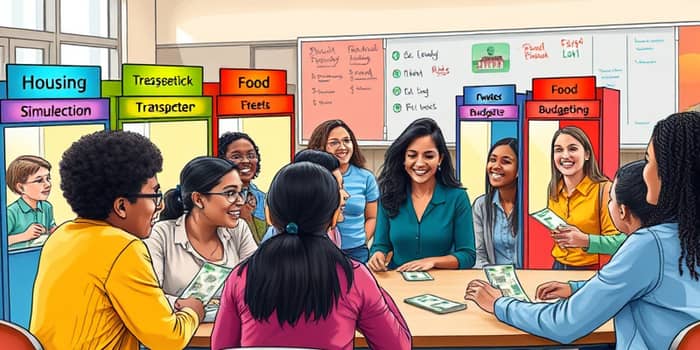
Teaching financial literacy can feel abstract when confined to textbooks and lectures. However, when students navigate real-life situations—such as renting an apartment, balancing a budget, or filing taxes—they develop lasting skills and confidence. By immersing learners in authentic challenges, educators can bridge the gap between theory and practice, ensuring students appreciate the stakes and rewards of sound money management. This article explores proven methods, inspiring case studies, and practical strategies to spark student engagement and foster lifelong financial well-being.
Financial concepts often remain intangible until learners apply them to their own lives. Without tangible experiences, students may forget formulas, ignore warnings about debt, or struggle to distinguish needs from wants. Real-world scenarios make abstract principles concrete, helping learners visualize consequences and rewards. Whether students role-play as young professionals managing paychecks or weigh insurance options for a simulated car accident, they internalize lessons far more effectively than by memorizing definitions.
Studies show that interactive, scenario-based approaches lead to deeper comprehension and improved retention. When learners decide whether to refinance a loan or invest in a mutual fund within a guided simulation, they build analytical skills, evaluate risks, and develop self-assurance. These benefits extend beyond the classroom, shaping positive financial behaviors well into adulthood.
Simulation programs immerse students in lifelike financial ecosystems. Two of the most impactful models include:
In these environments, learners earn simulated income, allocate resources, and navigate unexpected expenses. They negotiate insurance rates, compare loan offers, and balance credit card payments. By mirroring adult responsibilities, simulations cultivate empathy, critical thinking, and disciplined spending habits.
Project-based learning invites students to tackle meaningful financial challenges. For example, groups may plan a multi-city trip, draft realistic budgets, research investment opportunities, and present findings to peers. These activities encourage collaboration, creativity, and strategic planning.
Teachers can also integrate case studies where students weigh tradeoffs: Should they purchase new or used vehicles? How do varying interest rates affect long-term costs? Through guided reflection and debriefing, learners connect outcomes to underlying principles and personal values.
In-class exercises—such as Credit Score Jenga or Beans for Budgeting—transform concepts like debt management and resource allocation into hands-on experiences. Students visibly add or remove blocks, representing credit-building actions or missed payments, and immediately grasp the compounding effects of financial decisions.
Educators should focus on pillars that naturally align with scenario-based teaching:
By weaving these principles into real-world contexts, students see the relevance of each concept to everyday life. They learn not just the “how” but the “why” behind financial decisions, preparing them to make informed choices beyond graduation day.
Effective implementation requires intentional scaffolding and reflection. Educators should consider the following strategies:
Integrating technology—such as budgeting apps and online simulators—enhances accessibility and engagement, especially for tech-savvy learners. Tools like PiggyBot allow students to practice real-time transactions, set savings goals, and visualize spending patterns, reinforcing classroom lessons with digital experiences.
Quantitative and qualitative data underscore the impact of real-world financial education. Below is a summary of participation and reported outcomes from key programs:
Surveys indicate that participants report positive financial behaviors lasting months after program completion. Educators note increased confidence, better decision-making, and a willingness to discuss money openly—an essential step toward lifelong financial health.
By harnessing meaningful real-world projects and guided reflection, educators can transform financial literacy from a checkbox to a life-changing skill set. When students simulate careers, budgets, and unforeseen expenses, they encounter the complexities of adulthood in a supportive environment. This immersive approach instills resilience, critical analysis, and the conviction that they can chart their own financial paths.
Teachers like Emma report that students leave the classroom not only with improved scores but with genuine excitement about managing their money. Learners like Corey discover that the principles behind balance sheets and interest rates directly influence their life goals. Together, these experiences cultivate a generation equipped to make informed choices, adapt to economic challenges, and contribute meaningfully to their communities.
Ultimately, integrating real-world scenarios into financial education empowers students to navigate the uncertainties of tomorrow with knowledge, confidence, and purpose. By turning abstract theory into lived experience, we can foster a future where financial literacy is not just taught, but truly lived.
References













